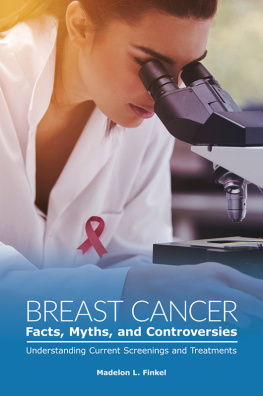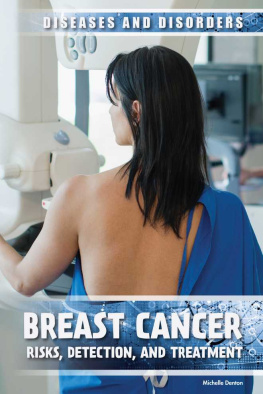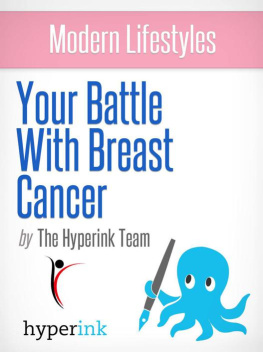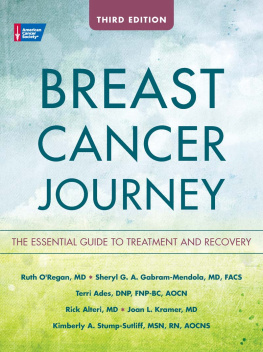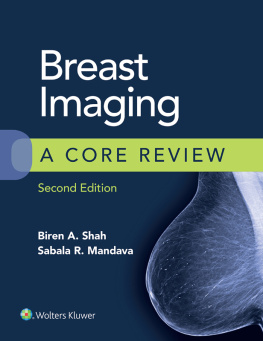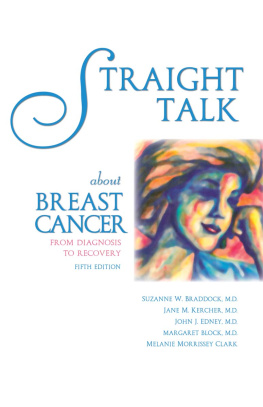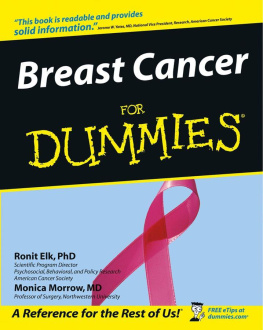Advanced Praise for Breast Cancer Facts, Myths, and Controversies
Dr. Finkels book comes at such an important time when there is a lot of information and misinformation related to breast cancer. This scientifically based book helps to clarify the complexities of breast cancer screening for the layperson. It also provides helpful information for patients about treatment options, support groups, and strategies to cope and thrive with breast cancer.
Dr. Rulla Tamimi, Professor of Population Health Sciences, Weill Cornell Medicine
Ambitious and engaging, Professor Finkel provides an exceptional overview of the complexities of breast cancer. Finkels personal experience is elegantly woven throughout and provides critical insight, from screening to treatment. An essential text for anyone looking to better understand the field.
Eloise May ODonnell, Senior Research Manager, Weill Cornell Medicine
Recent Titles in
Public Health Issues and Developments
The Human and Environmental Impact of Fracking: How Fracturing Shale for Gas Affects Us and Our World
Madelon L. Finkel, Editor
Breast Cancer Facts, Myths,
and Controversies
Understanding Current Screenings
and Treatments
Madelon L. Finkel, PhD
Public Health Issues and Developments

Copyright 2021 by Madelon L. Finkel
All rights reserved. No part of this publication may be reproduced, stored in a retrieval system, or transmitted, in any form or by any means, electronic, mechanical, photocopying, recording, or otherwise, except for the inclusion of brief quotations in a review, without prior permission in writing from the publisher.
Library of CongressCataloging-in-PublicationData
Names: Finkel, Madelon Lubin, 1949- author.
Title: Breast cancer facts, myths, and controversies : understanding current screenings and treatments / Madelon L. Finkel.
Description: Santa Barbara, California : ABC-CLIO, [2021] | Series: Public health issues and developments | Includes bibliographical references and index.
Identifiers: LCCN 2020048191 (print) | LCCN 2020048192 (ebook) | ISBN 9781440875137 (hardcover) | ISBN 9781440875144 (ebook)
Subjects: LCSH: BreastCancerTreatment. | BreastCancerRisk factors.
Classification: LCC RC280.B8 F557 2021 (print) | LCC RC280.B8 (ebook) | DDC 616.99/449dc23
LC record available at https://lccn.loc.gov/2020048191
LC ebook record available at https://lccn.loc.gov/2020048192
ISBN: 978-1-4408-7513-7 (print)
978-1-4408-7514-4 (ebook)
252423222112345
This book is also available as an eBook.
Praeger
An Imprint of ABC-CLIO, LLC
ABC-CLIO, LLC
147 Castilian Drive
Santa Barbara, California 93117
www.abc-clio.com
This book is printed on acid-free paper 
Manufactured in the United States of America
This book is dedicated to my beloved mother, Lorraine Lubin, and to all other women diagnosed with breast cancer. My mothers strength in coping with her disease never wavered, and she lived her life to its fullest, even during chemo treatments. She truly was a profile in courage for her daughters and granddaughters.
Contents
There has been so much written about breast cancer over the past decades, making it sometimes difficult for one to stay abreast of all the new surgical, radiological, and medical advances that have been made. While breast cancer continues to be the most commonly diagnosed cancer among women around the world, the good news is that breast cancer deaths have decreased substantially over time. This decline is attributed to improvements in treatment and early detection. The American Cancer Society estimates that there are more than 3.6 million breast cancer survivors in the United States, and hopefully the number will continue to increase.
Whether one develops breast cancer or not depends on many factors. Some women are at higher risk than others, and survival also differs, depending on an individuals genetic, demographic, and clinical factors. That being said, having one or more risk factors does not automatically imply that an individual will develop breast cancer. All it means is that the risk of breast cancer is higher among those with risk factors compared to those who have no risk factors. But, in fact, 85% of breast cancers occur in women who have no risk factors. It is complicated!
This book presents a comprehensive overview of breast cancer facts, myths, and controversies. I made sure to include the most up-to-date, scientifically rigorous published studies on the topics, and I discuss the findings and implications of the large-scale clinical trials on mammogram screening that were conducted decades ago. No large-scale clinical trials have been conducted in recent times.
I was motivated to write the book for many reasons, including experiencing firsthand my mothers bout with breast cancer, her years in remission, and the cancers return 10 years after the initial diagnosis. I found my training in epidemiology to be helpful in understanding the course of the disease, but woefully lacking in helping me to cope with the emotional roller coaster of her cancer treatments. Many of my friends who are breast cancer survivors would ask about treatment options, and I realized that navigating the system and understanding the pros and cons of these options was daunting. This book is an effort to explain the potential benefits and harms of existing and new therapeutics as well as the controversy surrounding the potential benefits and harms of mammography screening.
While new therapeutics hold great promise, they may not be uniformly effective for every woman. What may be the most appropriate drug for one person may not be for another. Precision medicine offers great hope to tailor treatment to an individual, but determining who will benefit from specific treatments is complex and somewhat imprecise. As we learn more about the short-term and long-term effects of each type of treatment, we inch closer to increasing survival from breast cancer. My hope is that the book will serve as a guide in understanding the complexities of breast cancer and the treatments for this disease.
Breast cancer screening has been touted as the best means to identify a tumor in its early stages and improve survival. Does mammography deliver on its promise? In our efforts to screen for early disease, are we doing more harm than good? To what extent does mammography detect something that would not have caused a problem if left alone? The book provides up-to-date information to address these and other questions.
There are literally tens of thousands of articles that have been published on the topic. I have tried to present the best evidence in a clear, concise manner so that the layperson can understand the issues and controversies. A helpful glossary of terms is included at the end of the book, as are breast cancer screening guidelines posted by leading organizations.
presents an historical overview of how art, literature, and society viewed the female breast. Over the course of history, psychiatrists, politicians, pornographers, religious leaders, artists, and writers have either rhapsodized or vilified the female breast. Marilyn Yalom, author of The History of the Breast, writes that the female breast is, at varying times, sources of wonder, pleasure, sensual delight, pain, humiliation, and anguish. The chapter concludes with a discussion of the different types of breast disease (benign and malignant) to illustrate how complex breast diseases are.

